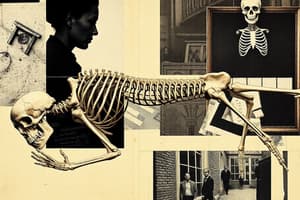Podcast
Questions and Answers
What role does the forensic anthropologist play in the medicolegal death investigation?
What role does the forensic anthropologist play in the medicolegal death investigation?
The main focus of a forensic anthropologist is to process crime scenes, examine and process remains, develop a biological profile, compile appropriate documentation, and testify in court.
Name some skills of forensic archaeologists and describe the situations in which those skills are likely to be applied.
Name some skills of forensic archaeologists and describe the situations in which those skills are likely to be applied.
Forensic archaeologists document how remains are positioned, map a scatter pattern, and document the relationship between body parts and other evidence.
What does interpreting the condition of remains with regard to their taphonomic context mean?
What does interpreting the condition of remains with regard to their taphonomic context mean?
It means reconstructing the post-mortem period based on the condition of the remains and the recovery context, including evidence of trauma.
What is likely included in a biological profile generated by forensic anthropologists?
What is likely included in a biological profile generated by forensic anthropologists?
What factors may limit the ability of anthropologists to attribute sex to a set of remains?
What factors may limit the ability of anthropologists to attribute sex to a set of remains?
What features of long bones are important in estimating age?
What features of long bones are important in estimating age?
List several skeletal or dental features that can be used to estimate adult age.
List several skeletal or dental features that can be used to estimate adult age.
How does the social construction of race affect anthropologists' judgments regarding ancestry evidence?
How does the social construction of race affect anthropologists' judgments regarding ancestry evidence?
What might limit the precision of methods estimating stature based on long bone length?
What might limit the precision of methods estimating stature based on long bone length?
When a forensic anthropologist testifies as an expert witness, for which side might they testify?
When a forensic anthropologist testifies as an expert witness, for which side might they testify?
What is forensic anthropology?
What is forensic anthropology?
What does forensic taphonomy refer to?
What does forensic taphonomy refer to?
What is forensic archaeology?
What is forensic archaeology?
What is the perimortem period?
What is the perimortem period?
What does morphology mean in the context of anthropology?
What does morphology mean in the context of anthropology?
What do osteology and odontology study?
What do osteology and odontology study?
What is stature in a forensic context?
What is stature in a forensic context?
Flashcards are hidden until you start studying
Study Notes
Forensic Anthropology Overview
- Forensic anthropologists process crime scenes, examine human remains, develop biological profiles, and provide court testimony.
- Their role differs from forensic pathologists and medical examiners, who focus on determining causes of death.
Recovery of Human Remains
- Forensic archaeologists document the positioning of remains and map scatter patterns at crime scenes.
- Their skills are essential in processing buried remains and relating body parts to other evidence.
Taphonomic Context
- Taphonomy studies the postmortem changes that affect remains and their recovery.
- Forensic anthropologists must consider taphonomic context, such as trauma evidence and decay, which may delay access to remains.
Biological Profile Components
- A biological profile includes age, sex, stature, ancestry, anomalies, pathology, and individual features of the remains.
Determining Sex from Remains
- Factors like decomposition and loss of distinctive physical features (e.g., genitalia) may complicate sex estimation from skeletal remains.
Estimating Age from Long Bones
- Diaphyses (long bone shafts) are compared with age-related size tables to estimate age.
- Features of long bones provide essential data for age estimation.
Adult Age Estimation Methods
- Methods include examining skeletal and dental features, such as scoop or radiographic images.
- These methods can vary in precision.
Race and Ancestry Judgments
- The socially constructed concept of race can influence anthropologists' assessments of ancestral evidence and may lead to biases.
Estimating Stature
- Stature estimations rely on long bone lengths, but precision can be affected by bone decay or muscle tissue loss.
Expert Testimony
- Forensic anthropologists must maintain scientific neutrality when testifying, regardless of which side they support in legal proceedings.
Definitions of Forensic Anthropology
- A field focused on investigating death and injury for legal purposes, both criminal and civil.
Key Terms
- Forensic Taphonomy: Study of outdoor death scenes and postmortem processes.
- Forensic Archaeology: Techniques for recovering scattered or buried remains.
- Perimortem Period: Timeline associated with the events surrounding death, including trauma.
- Morphology: Study of human shape and size variations.
- Osteology and Odontology: Disciplines that focus on dental and skeletal anatomy.
- Stature: Measurement of natural height.
Studying That Suits You
Use AI to generate personalized quizzes and flashcards to suit your learning preferences.



